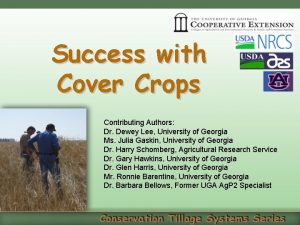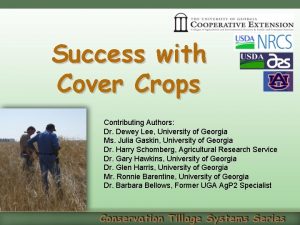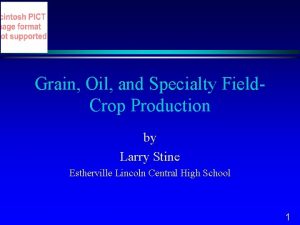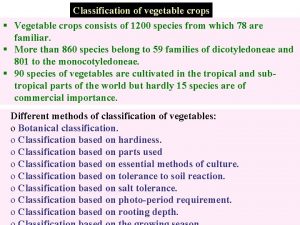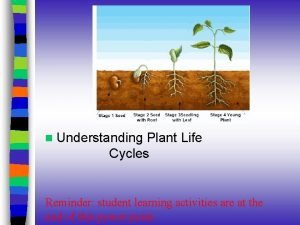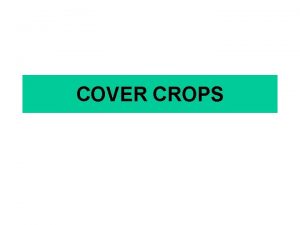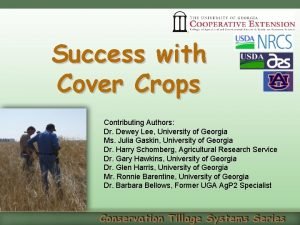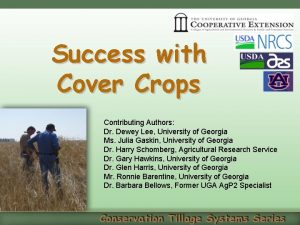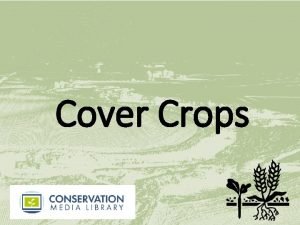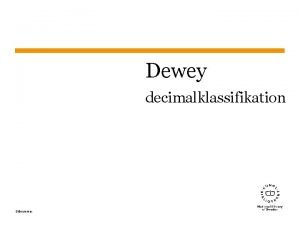Success with Cover Crops Contributing Authors Dr Dewey

Success with Cover Crops Contributing Authors: Dr. Dewey Lee, University of Georgia Ms. Julia Gaskin, University of Georgia Dr. Harry Schomberg, Agricultural Research Service Dr. Gary Hawkins, University of Georgia Dr. Glen Harris, University of Georgia Mr. Ronnie Barentine, University of Georgia Dr. Barbara Bellows, Former UGA Ag. P 2 Specialist

Why Cover Crops? • • • Reduces erosion Improves soil quality Minimizes nutrient loss Improves water quality Increases water infiltration and storage and reduces risk of short-term drought • Reduces weed populations • Supplies nitrogen from legumes

Maximize Biomass • • • Maintain soil fertility and p. H Plant good quality seed Establish a good stand Inoculate legume seeds – specific & fresh Plant early Terminate late

Selection of Cover Crops • What is your cash crop? • What are your desired benefits? • What are your growing conditions? • What is your experience level?

Selecting Cover Crops What is your cash crop? • Peanuts or soybeans: any small grain • Corn: cereal rye, triticale or legume • Cotton: any small grain or legume • Vegetables: cereal rye, triticale, millets or legumes

Selecting Cover Crops • What are your desired benefits? – Nitrogen • Crimson clover or hairy vetch – Reducing weed pressure • Rye/black oats, triticale or wheat - Water conservation • Rye/oats, triticale or wheat Annual rye - note heavy residue and no weeds

Selecting Cover Crops • What are your desired benefits? – Erosion control • Aim for 100% cover – Minimizing nutrient loss • Deep-rooted covers (rye) – Improving soil and water quality • Cover crops in general

Selecting Cover Crops • What are your field conditions? – – Wet soils p. H Sandy vs. clay Winter temperatures

Selecting Cover Crops • What is your experience level? → None = wheat → Some = rye → A lot = clover or mixtures

Planting Cover Crops • Planting dates • Planting method • Seeding rates • Pest control

Planting Cover Crops • Planting Date – Fall planting • Cool season small grains and legumes – Spring and Summer • Warm season grasses and legumes Rye planted: Nov. vs. Oct.

Planting Cover Crops • Planting methods – Drill or direct seeding preferred – Broadcast • Prior to peanut harvest • Prior to cotton defoliation • Broadcast and incorporate seed by harrowing or cultivating – Be very careful of seed depth • Tillage – Avoid soil compaction – wet soil – Deep tillage (paraplow, chisel or subsoil shank) improves biomass production

Planting Cover Crops • Seeding rate – Drilling takes less seed than broadcasting. • Seeding depth – Grasses and large seeded legumes should be planted 1 to 1. 5 inches deep. – Plant smaller seed 0. 25 to 0. 5 inches deep. Cover Drilling (7. 5”) Broadcasting Seeds per row ft. Seeds per Sq. ft. Wheat 15 to 18 40 to 45 Oat 12 to 15 25 to 30 Triticale 15 to 18 40 to 45 Rye 18 to 22 45 to 50 Lbs. per acre Crimson clover 12 to 15 20 to 30 Hairy vetch 15 to 20 25 to 35 Millet 8 to 10 20 Sorghum-sudan 15 to 20 30 60 120 30 to 40 60 to 70 Small grains Legumes Grasses Legumes Velvet bean Cowpea

Planting Legume Cover Crops • Seed treatments for legumes – Inoculants Note nodules on roots

Pest Control in Cover Crops • Herbicides – May need to control weeds – Carry-over from previous crop • Insects – Hessian fly and aphids • Seed treatments for small grains – Fungicides

Cover Crop Fertility • Small grains and summer grasses – Need nitrogen • Cool season and summer legumes – Fix nitrogen

Fertility • Small Grains – Add N to get more biomass production • Fall applications of N if cover is for corn • Winter applications of N if cover is for cotton, peanut, soybean or grain sorghum • Legumes – Proper inoculant will produce 50 to 150 lbs. N

Terminating Cover Crops • Timing Low biomass, quick decomposition High biomass, slow decomposition

Cover Crop Decomposition • C: N ratio > 25 -30 results in nitrogen immobilization • Cover crops and C: N ratio – – Small grains have high C: N ratio Mature, older crops have high C: N ratio Legumes have low C: N ratio Succulent, young crops have low C: N ratio

Small Grain Termination • Late termination for higher weed suppression • Terminate three to four weeks before planting to reduce – Soil moisture depletion – Insect pressure – Allelopathy effects on the following crop Note weed suppression in cotton

Legume Termination • More difficult to terminate than small grains • Manage to allow reseeding if possible Note reseeded crimson clover

Terminating Cover Crops • Termination method – Burn-down herbicides

Terminating Cover Crops • Termination method – Roller-crimpers Anybody have a better picture of auburn rollers or the latest version?

Cover Cropping Summary • Cover cropping provides environmental, production and economic benefits when used in a conservation tillage system • Maximum benefits come from maximum biomass • Cover cropping needs to be managed carefully to provide desired benefits

Cover Crop Resources • Cover crops at UGA http: //www. caes. uga. edu/commodities/sustainag/cont illage/index. html • Managing Cover Crops Profitably, 2 nd ed. Sustainable Agriculture Network http: //www. sare. org/publications/covercrops/covercr ops. pdf • Sustainable Practices for Vegetable Production in the South http: //www. cals. ncsu. edu/sustainable/peet/index. htm l • National Sustainable Agriculture Information Service (ATTRA) http: //www. attra. org

Information in this presentation was developed through a cooperative effort between: Auburn University

Electronic Bulletin 102 / Reviewed March 2014 The University of Georgia, Fort Valley State University, the U. S. Department of Agriculture and counties of the state cooperating. UGA Extension offers educational programs, assistance and materials to all people without regard to race, color, national origin, age, gender or disability. The University of Georgia is committed to principles of equal opportunity and affirmative action.
- Slides: 27

